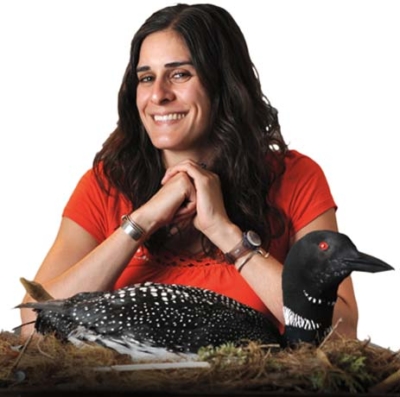 Biology instructor Camilla Fecteau explains how a beloved bird’s fate is linked to our own.
Biology instructor Camilla Fecteau explains how a beloved bird’s fate is linked to our own.
Play word association with Maine, and chances are good that most people will reflexively say lobsters or lighthouses. But wildlife biologist and instructor Camilla Fecteau would be pleased to no end if the pat response were instead loons. Why? Because, she believes, any public awareness that activates environmental safeguards for the region’s loons could wind up saving its human inhabitants, too.
Fecteau made the first of her many field-based studies and surveys of loons in 2005, during six months of research on Lake Umbagog, which straddles the Maine-New Hampshire border. When she’s invited by regional lake associations to speak about various threats to loon populations – everything from boat collisions to lead poisoning from ingesting discarded fishing sinkers (the leading known cause of death among New Hampshire’s adult loons) – the topic that gets the most time is mercury pollution.
And her primer on this complex hazard to loons begins with how electricity-producing practices in states to the south and west have a toxic impact on lakes and rivers in Maine, New Hampshire and other points downwind.
“The number-one source of mercury in the atmosphere is coal-fired power plants,” explains Fecteau, who graduated from University of Maine at Farmington and earned her master’s degree at University of Southern Maine. “In its natural state, mercury on the planet is locked up safely underground. But when we unearth and burn coal, we release that mercury into the air.”
When that mercury gets deposited in the lakes and rivers of northern New England through rain and snow, explains Fecteau, it binds with sulfur (often abundant in low-oxygen aquatic environments) to form mercury sulfide, which can readily pass into bacterial cell membranes. After bacterial cells receive mercury sulfide, they release a neurotoxin, known as methyl mercury, back into the environment, where it can be taken up by plankton.
“Fish eat the plankton, and loons eat the fish,” she says. “As methyl mercury moves up the food chain, the levels increase through bioaccumulation in high-trophic level organisms – the animals near the top of the food chain.”
Fecteau says loons can expel some methyl mercury through “depuration,” which refers to excretion through molting (similar to the way humans expel toxins through hair growth) and laying eggs. “That’s good for the mother,” she says, “but obviously not for the offspring.”
Over a lifetime of up to 30 years, however, a loon may accumulate more of the neurotoxin than it can ever discharge. And Fecteau says that even though a loon probably wouldn’t ever ingest enough methyl mercury to kill it outright, the cognitive effects of the bioaccumulation signal only a slower and more heartbreaking demise for the species.
“Methyl mercury affects the central nervous system, and we’re increasingly seeing loons that are, for lack of better words, foggy-headed,” she says. “They’re making more little mistakes in the reproductive process. They’re not as attentive during incubation and sometimes stay off the nest too long, leaving their eggs and young exposed to predators.”
And it doesn’t take much imagination to see other dire consequences.
“If chicks are cognitively affected as well,” she says, “perhaps they won’t learn how to fish properly from parents or successfully adopt other modeled behaviors to survive.”
Despite her passion for loons, Fecteau says she endeavors “not to get preachy.” Her non-scientific audiences, she says, tend to realize on their own that humans, like loons, are a high-trophic level species with the same capacity to bioaccumulate – and even longer life spans in which to aggregate neurotoxins like methyl mercury. The Maine Department of Health & Human Services makes this point clearly on its website: “Pregnant and nursing women, women who may get pregnant, and children under age 8 should not eat any freshwater fish from Maine’s inland waters.” (The only exceptions, says the DHHS, are brook trout and landlocked salmon; one meal per month is okay for the aforementioned populations.)
Fecteau expects her research on kingfisher populations (another high-trophic level bird with feeding habits similar to the loon) to get published in the journal Ecotoxicology. While publication is important, she’s committed to continue presenting her research “in layman’s terms” because “most of the public doesn’t read peer-reviewed scientific journals,” she says. “If you cannot communicate the importance of the research outside the scientific community, then what good is it?”
And what becomes important to the public, she believes, stands a chance of becoming environmental policy and law. As loons are, she says, an “indicator species” for environmental health, they make a compelling exemplar in educating non-scientific audiences.
“I like to talk about a large, majestic bird that people really love and show why they’re threatened with decline,” she says. “If we could even minimally decrease our electricity use or turn to green energy sources, we could reduce the amount of mercury that follows weather patterns and gets deposited through rain and snow. Higher energy costs are a hard pill to swallow, especially now. But we can look at what’s happening to loons as a predictor of what might happen to us.”

